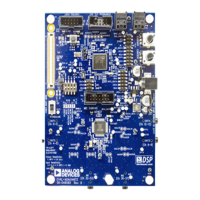EVAL-ADAU1467Z UG-1134
Rev. A (Draft) | Page 15 of 55
The signals pass through the AD1937 ADCs and then are sent
to the ADAU1467 serial input ports in I
2
S format. The mapping
of input signals to input channels in SigmaDSP and SigmaStudio
is shown in Table 1. See the Error! Reference source not found.
section for the configuration of the
SDATAIOx pins.
Table 1. Mapping of Stereo Analog Input Signals to SigmaStudio Channels
Input Jack Plug Contact AD1937 ADC Pins ADAU1467 Serial Input Pins Input Channel in SigmaStudio
J14 Left (tip) ADC1LN, ADC1LP SDATA_IN2 32
J14 Right (ring) ADC1RN, ADC1RP SDATA_IN2 33
J15 Left (tip) ADC2LN, ADC2LP SDATAIO4 36
J15 Right (ring) ADC2RN, ADC2RP SDATAIO4 37
Stereo Line Outputs
Four stereo output jacks allow eight line level analog output signals.
The AD1937 DAC outputs are configured such that a full-scale
signal is 2.8 V p-p at the jack, which is approximately 1 V rms
for a sine wave. The signals output from the DACs are fed to active
low-pass filters and then ac-coupled before reaching the output
jacks. The filters are designed for a system sample rate of 44.1 kHz
or 48 kHz.
The output filters are designed to drive high impedance loads,
for instance, loads at the input to active speakers. Some low
impedance loads (for example, loads from headphones) can also
be driven by these outputs. However, very low impedance loads
(for example, loads from passive speakers) cannot be driven by
these outputs.
The stereo output jacks accept standard stereo TRS 3.5 mm
(1/8 inch) mini plugs (tip connected to left, ring connected to
right, sleeve connected to ground) with two channels of audio
(see Figure 37).
The signals pass from the ADAU1467 serial outputs in I2S
format to the AD1937 DACs, where they are converted to
analog signals and sent through the output filters to the output
jacks. The mapping among the SigmaStudio output channels,
output serial ports, and output jacks is shown in Table 2.
See the Configuring the SDATAIOx Pins for the ADCs and
DACs section for the configuration of the SDATAIOx pins.
Table 2. Mapping of SigmaStudio Channels to Output Jacks
Output Jack Plug Contact AD1937 DAC Pin ADAU1467 Serial Output Pin Output Channel in SigmaStudio
J12 Right (ring) OR1 SDATA_OUT0 1
J13 Left (tip) OL2 SDATAIO5 4
J13 Right (ring) OR2 SDATAIO5 5
J18 Left (tip) OL3 SDATAIO6 8
J18 Right (ring) OR3 SDATAIO6 9
J17 Left (tip) OL4 SDATAIO7 12
J17 Right (ring) OR4 SDATAIO7 13
Configuring the SDATAIOx Pins for the ADCs and DACs
The EVAL-ADAU1467Z demonstrates how the SDATAIOx pins
make serial ports on the ADAU1467 more flexible. Only one
input serial port and one output serial port is required to connect
the ADAU1467 to the AD1937 codec using only stereo digital data
lines. The remaining serial ports are available to connect to
other audio inputs and outputs.
The SDATAIOx pins provide additional serial audio data inputs
or outputs and expand the functionality and versatility of the
serial ports. In earlier generations of the SigmaDSP architecture,
serial ports are limited to a single SDATA pin. If this serial data
pin is configured in a stereo mode, the remaining channels
associated with the port are inaccessible. Device interfaces with
a single LRCLK and BCLK pair and multiple stereo data lines
(for example, in a case with multiple connections in the I
2
S
format) required using multiple SigmaDSP serial ports.
The SDATAIOx pins on the ADAU1467 eliminate this bottleneck.
The connection between the SigmaDSP and the AD1937 codec
uses four I
2
S data lines for the eight DAC channels and two I
2
S
data lines for the four ADC channels. The
EVA L -ADAU1467Z supplements the SDATA_OUT0 pin
with three SDATAIOx pins and the SDATA_IN2 pin with one
SDATAIOx pin. This configuration connects all of the audio
channels of the AD1937 while using only one input serial port
and one output serial port. The connections are shown in
Figure 38.

